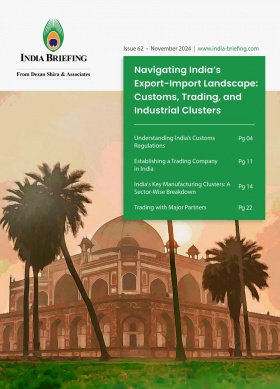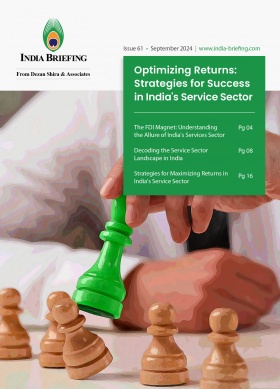India-Morocco Strategic Partnership: A Convergence of Regional and Global Aspirations
The growing partnership between India and Morocco reflects a convergence of strategic interests as both nations seek to expand their influence in Asian, African, and European markets.
Key areas of collaboration
Morocco’s geographical position as a bridge between the continents of Europe and Africa provides India with a strategic entry point to expand its influence in these regions.
The partnership between India and Morocco spans various critical areas.
In defense and military cooperation, both nations engage in joint military exercises and intelligence-sharing, which enhance regional security and address shared challenges such as combating terrorism and ensuring maritime safety.
In the realm of food and health security, collaboration focuses on agricultural innovation and public health initiatives. Morocco’s phosphoric acid and phosphate exports play a key role in supporting India’s agricultural sector, ensuring food security for a growing population.
For energy transition and sustainability, both nations prioritize renewable energy initiatives. Morocco aims to lead Africa in green energy, while India seeks to expand its global sustainability footprint, fostering mutual benefits and aligning with broader environmental goals.
Economic and trade relations
Economic and trade relations between India and Morocco have witnessed significant growth. Bilateral trade surged from US$2.007 billion in 2018-19 to US$3.597 billion in 2022-23, driven primarily by increased imports of Moroccan phosphates and raw materials. India, in turn, exports textiles, pharmaceuticals, vehicles, and machinery, highlighting its industrial capacity and diversification goals.
|
India and Morocco Trade Relations (Value in US$ Million) |
|||||
|
Trade |
FY 2019-20 |
FY 2020-21 |
FY 2021-22 |
FY 2022-23 |
FY 2023-24 |
|
India’s export to Morocco |
799.45 |
507.62 |
962.28 |
1,047.15 |
1,032.58 |
|
Growth % |
– |
-36.5 |
89.57 |
8.82 |
-1.39 |
|
India’s import from Morocco |
952.54 |
1,436.82 |
2,244.19 |
2,549.44 |
1,404.28 |
|
Growth % |
– |
50.84 |
56.19 |
13.6 |
-44.92 |
|
Total |
1,751.99 |
1,944.44 |
3,206.47 |
3,596.59 |
2,436.86 |
|
Growth % |
– |
10.98 |
64.9 |
12.17 |
-32.25 |
Source: Department of Commerce, Ministry of Commerce and Industry, GoI
|
India’s Export to Morocco (Value in US$ Million) |
|||
|
Commodity |
FY 2022-23 |
FY 2023-24 |
Growth % |
|
Articles of iron or steel |
16.44 |
156.36 |
851.02 |
|
Vehicles other than railway or tramway rolling stock, and parts and accessories thereof. |
195.1 |
119.47 |
-38.77 |
|
Mineral fuels, mineral oils and products of their distillation; bituminous substances; mineral waxes. |
195.71 |
90.06 |
-53.99 |
|
Pharmaceutical products |
46.06 |
58.64 |
27.3 |
|
Nuclear reactors, boilers, machinery and mechanical appliances; parts thereof. |
70 |
55.58 |
-20.6 |
|
Cotton. |
50.82 |
51.83 |
1.98 |
|
Coffee, tea, mate and spices. |
40.1 |
50.24 |
25.27 |
|
Man-made filaments. |
58.92 |
48.84 |
-17.11 |
|
Electrical machinery and equipment and parts thereof; sound recorders and reproducers, television image and sound recorders and reproducers,and parts. |
47.42 |
47.67 |
0.53 |
|
Organic chemicals |
29.51 |
36.7 |
24.39 |
|
Plastic and articles thereof. |
49.47 |
29.46 |
-40.44 |
|
Man-made staple fibres. |
36.7 |
25.68 |
-30.03 |
|
Cereals. |
19.87 |
23.88 |
20.19 |
Source: Department of Commerce, Ministry of Commerce and Industry, GoI
|
India’s Imports from Morocco (Value in US$ Million) |
|||
|
Commodity |
FY 2022-23 |
FY 2023-24 |
Growth % |
|
Fertilisers. |
1,466.35 |
607 |
-58.6 |
|
Inorganic chemicals; organic or inorganic compounds of precious metals, of rare-earth metals, or radi. Elem. Or of isotopes. |
651.24 |
482.55 |
-25.9 |
|
Salt; sulphur; earths and stone; plastering materials, lime and cement. |
366.57 |
273.36 |
-25.43 |
|
Aluminium and articles thereof. |
17.86 |
9.72 |
-45.55 |
|
Iron and steel |
11.96 |
7.81 |
-34.7 |
|
Electrical machinery and equipment and parts thereof; sound recorders and reproducers, television image and sound recorders and reproducers,and parts. |
7.35 |
7.01 |
-4.65 |
|
Pulp of wood or of other fibrous cellulosic material; waste and scrap of paper or paperboard. |
7.7 |
2.93 |
-61.9 |
|
Plastic and articles thereof. |
1.09 |
2.11 |
93.96 |
|
Oil seeds and olea. Fruits; misc. Grains, seeds and fruit; industrial or medicinal plants; straw and fodder. |
4.23 |
1.89 |
-55.33 |
|
Ores, slag and ash. |
1.06 |
1.49 |
40.25 |
|
Nuclear reactors, boilers, machinery and mechanical appliances; parts thereof. |
3.48 |
1.25 |
-64.02 |
|
Other base metals; cermets; articles thereof. |
2.21 |
1.09 |
-50.75 |
|
Lac; gums, resins and other vegetable saps and extracts. |
0.04 |
1.07 |
2,369.91 |
Source: Department of Commerce, Ministry of Commerce and Industry, GoI
Additionally, joint ventures in renewable energy, agriculture, and tourism show deepening economic ties. India’s investments in Morocco’s green energy sector align with global sustainability objectives, while the development of tourism infrastructure leverages Morocco’s strategic location as a gateway to Europe and Africa.
Institutional mechanisms
India and Morocco have established institutional frameworks to strengthen bilateral relations across various sectors.
Double Taxation Avoidance Agreement
The India-Morocco Double Taxation Avoidance Agreement (DTAA) is a bilateral treaty aimed at fostering economic cooperation and investment between the two nations by preventing the double taxation of income. Signed in August 2019, the agreement promotes cross-border trade and investment by ensuring that taxpayers are not taxed on the same income in both countries. It provides clarity on taxation rights, particularly for income derived from services, businesses, and property, and includes provisions to prevent tax evasion.
|
Recipient Country |
Withholding Tax Rates (%) from Certain Types of Income |
|||
|
Morocco |
Dividend |
Interest |
Royalty |
Fee for technical services |
|
10 |
10 |
10 |
10 |
|
Source: India Briefing
Joint Working Groups (JWGs)
- The first JWG on counter-terrorism convened in Rabat on December 29, 2022.
- The second JWG on Health met virtually on January 12, 2023.
- The second JWG on Renewable Energy was held on January 24, 2023.
- The second Joint Committee under the MoU on Mining and Geology convened on February 2, 2021.
- The third JWG on water resources met on July 6, 2021.
- The first JWG on fertilizers was held virtually on March 10, 2023.
Indian business presence in Morocco
Indian companies are significantly represented in Morocco, contributing to various industries:
- Notable ventures include IMACID (a Birla-Tata joint initiative with Morocco’s OCP), Sun Pharma, CIPLA, Tata Motors, and Larsen & Toubro.
- Companies such as Sterling and Wilson, Gujarat Fluorochemicals Ltd., and Varroc Lighting Systems are active in technology and manufacturing.
- HCL has recently established a center in Technopolis, Rabat, and Samta Group has entered Morocco’s mining sector.
- Indian automobile giants like Tata Motors and Mahindra & Mahindra are steadily gaining traction in the Moroccan market.
Information technology and start-ups
The Centre of Excellence in Information Technology (CEIT), a project of the India-Morocco Economic Cooperation Programme, was established in Casablanca’s Technopark under the IAFS-II development program. It commenced its operations on December 18, 2017, jointly managed by C-DAC, India’s research and development (R&D) organization in the field of IT and electronics, and INPT, an IT and telecommunications institute in Morocco.
According to the India Morocco Chamber of Commerce and Industry, since its inception, CEIT has trained 675 Moroccan students and professionals and was officially handed over to Moroccan authorities in January 2020.
Meanwhile, Indian participation in Morocco’s tech ecosystem is expanding, with over 25 Indian companies and start-ups showcasing their product innovation at Gitex Africa in Marrakesh from May 31 to June 2, 2023.
Conclusion
Morocco is an important partner for India’s engagement in North Africa, acting as a gateway to African and European markets, while India leverages Morocco’s strategic location to pursue its economic and political objectives in these regions.
The deepening of trade relations, joint ventures, institutional engagement, and corporate partnerships will drive economic growth for both nations, aligning with global sustainability goals and opening new avenues for investment.
Such partnership reinforces south-south cooperation and can provide solutions to challenges specific to developing nations. Additionally, joint security and defense initiatives enhance regional stability by addressing emerging threats and fostering mutual trust between the two countries.
About Us
India Briefing is one of five regional publications under the Asia Briefing brand. It is supported by Dezan Shira & Associates, a pan-Asia, multi-disciplinary professional services firm that assists foreign investors throughout Asia, including through offices in Delhi, Mumbai, and Bengaluru in India. Readers may write to india@dezshira.com for support on doing business in India. For a complimentary subscription to India Briefing’s content products, please click here.
Dezan Shira & Associates also maintains offices or has alliance partners assisting foreign investors in China, Hong Kong SAR, Dubai (UAE), Indonesia, Singapore, Vietnam, Philippines, Malaysia, Thailand, Bangladesh, Italy, Germany, the United States, and Australia.
- Previous Article India Working on New GCC Policy to Tap Sector Growth with Fresh Incentives
- Next Article India Extends IT Hardware Import Management System Until December 31, 2025








